| Article ID | Journal | Published Year | Pages | File Type |
|---|---|---|---|---|
| 7446371 | Journal of Archaeological Science: Reports | 2015 | 13 Pages |
Abstract
Recent archeological excavations at Kastas tumulus (Amphipolis, Northern Greece) have revealed structures within the tumulus that have provided an excellent opportunity to reassess a seismic tomography survey of the tumulus, improving the geophysical imaging and the archeological understanding of the tumulus structure. We reevaluated and reprocessed the original dataset, considering the findings of the on-going excavation. We studied in detail the velocity distribution of expected burial structures and tested the detection ability of tomography using various target object positions, shape and dimensions. An updated inversion of the traveltime data verifies and improves the original result. The stone-lined dromos leading to the interior of the monument is imaged as a low-velocity area, as are other low-velocity areas possibly related to additional access walkways and funeral chambers. The circular stone wall surrounding the tumulus, not a target of the survey, was not imaged due to target and site peculiarities and the method's detection ability. However, part of a low-velocity anomaly that runs along the original foot of the hill successfully images the deep soil-filled trench in which the wall is buried, providing indirect evidence for the existence of a significant structure related to the tumulus. The results of the present study strongly support the use of seismic traveltime tomography as a robust tool for investigating burial mounds, particularly beneficial for locating funeral chambers and other structures at the deepest levels of a tumulus, which are usually beyond the imaging ability of other methods commonly applied in archeological prospecting.
Related Topics
Social Sciences and Humanities
Arts and Humanities
History
Authors
Lazaros Polymenakos, Daryl Tweeton,
